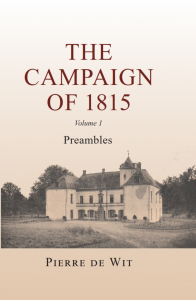
The Campaign of 1815, Volume I ‘Preambles’
Pierre de Wit
Published by Glimpse Editions (2022)
https://www.waterloo-campaign.nl/volumes/
Hardback, 555 pp.

Any one who has delved into the waterloo-campaign.nl website over the last decade or more, will know of the wealth of material accumulated from all armies, by the renowned historian Pierre de Wit. Pierre has now decided to take the website down and to utilise all of this mass of material in a stupendous ten volume set, covering the entire Waterloo campaign in infinite detail.
The volumes will each cover a specific event or time period in huge detail.
Volume 1 – ‘Preambles – March to 14 June 1815
Volume 2 – ’15 June’
Volume 3 – ‘Ligny’
Volume 4 – ‘Quatre Bras’
Volume 5 -’17 June’
Volume 6 – ‘Waterloo (Part 1)’ – Up to 4pm
Volume 7 – ‘Waterloo (Part 2)’ – From 4pm
Volume 8 – ‘Invasion’ – Wavre and the March to Paris
Volume 9 – ‘Addendum’ – Non-British sources in their original languages
Volume 10 – ‘Atlas’
These will be published over the next three years; volumes 1 & 2 are currently available (October 2022) and volume 3 will be published by the end of the year.
Volume 1 ‘Preambles’
The look and feel of the book is excellent, this particular volume covering Napoleon’s return to power until 14 June, consists of 391 pages of text and 11 illustrations within the text. Learned notes then cover a staggering 128 pages, with a 16-page bibliography, finally there is a 24-page index.
This book presupposes a good level of knowledge of the 1815 campaign and immediately launches into a discussion of Napoleon’s problems on returning to power. This is a little jarring, with no real preamble of what had gone before, nor description of Napoleon’s return from Elba or his famous march to Paris. This is perhaps understandable given the size of the book already, but a few pages setting the scene might have been worthwhile.
Pierre launches immediately in Part 1 into an in-depth analysis of the state of France and its army on Napoleon’s return, his efforts to bolster his forces and his options to counter the proposed invasion of France by the allies.
Part 2 consist of an excellent appreciation of the assembly of both Wellington’s forces (in limited detail), but perhaps more importantly that of the Prussians and Netherlands, which rarely receives much attention in histories of this campaign. It continues by looking in the most intricate detail at the intense supply issues this large Prussian force caused for the King of the Netherlands. Much further discussion centres around the numerous documents collected by Pierre, showing how Wellington and Blucher/Gneisenau saw the campaign playing out and their plans/concerns over both the planned invasion of France (and the reasons for its constant delays) and what to do in the event of a pre-emptive invasion of Belgium by Napoleon – confused by the numerous options regarding routes of attack the Emperor could choose.
Part 3 covers again in infinite detail, the huge amount of planning required to attempt to form a concentration of the French army near the border, without giving the allies any warning, thereby giving them no opportunity to order counter measures until his point of attack became certain. It also explains why the French army was unable to meet the original planned attack date of the 14 June and how the delay of 24 hours had both advantages and disadvantages.
It is to be frank, extraordinary that so much can be written on this limited subject matter and there is some unavoidable repetition of arguments, but all of the various reports and orders covering this period are produced if not fully, but to a great extent and all in English, which is of huge value to those whose military French/German/Dutch is not of a high standard. Despite this there are a few surprising omissions, the author being vague on the ‘alarm’ in May and the whereabouts of Vivian and Vandeleur’s troops at some points, when the papers of General Sir Henry Clinton and the Brigade Orders of Vivian have been fully published in recent years and make these issues clear.
Pierre’s conclusions may sometimes be questioned, but he does write at exhaustive length why he leans towards his conclusions and certainly makes his case well, whether the reader always agrees is of course their prerogative.
The bibliography is strangely lacking in a number of more recent books on this subject, but perhaps they may appear in later volumes. One minor criticism of the endnotes, is that they are simply arranged as 1-1205, making constant referral to the back whilst reading quite irksome; it would have certainly helped if they were grouped by chapter.
This is not a series of volumes for the casual reader, but for someone who wants to gain the most intricate understanding of the 1815 campaign ever produced, particularly at a ‘grand strategy’ level, if that is what you desire then these are for you. They are of course highly recommended, and I am immediately hungry to read volume 2.
